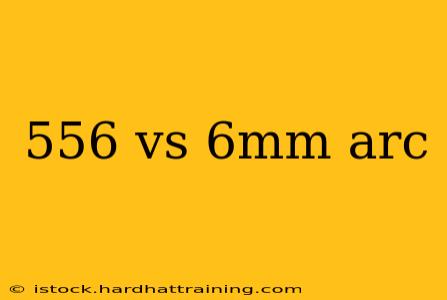5.56 vs 6mm ARC: A Detailed Comparison for Shooters
Choosing the right caliber for your firearm is a crucial decision, impacting accuracy, effectiveness, and overall shooting experience. This comparison dives deep into the 5.56x45mm NATO and the relatively newer 6mm ARC (Advanced Rifle Cartridge), helping you understand their strengths and weaknesses to make an informed choice.
Understanding the Contenders: 5.56 NATO and 6mm ARC
The 5.56x45mm NATO is a long-standing standard, renowned for its widespread availability, affordability, and light recoil. Its smaller projectile, however, means it can be susceptible to wind drift at longer ranges and may exhibit less stopping power compared to larger calibers.
The 6mm ARC, a more recent entrant, aims to address some of the 5.56's shortcomings. Designed with precision and long-range performance in mind, it offers a higher ballistic coefficient and improved downrange energy, making it a strong contender for both tactical and hunting applications. However, its newer status translates to potentially higher ammunition costs and limited availability compared to the ubiquitous 5.56.
Key Differences: A Head-to-Head Analysis
| Feature | 5.56x45mm NATO | 6mm ARC |
|---|---|---|
| Caliber | 5.56mm | 6mm |
| Case Length | 45mm | 39mm |
| Ballistic Coefficient | Lower | Significantly Higher |
| Recoil | Lighter | Moderate |
| Range | Shorter, more affected by wind | Longer, less affected by wind |
| Ammunition Cost | Lower | Typically Higher |
| Availability | Extremely High | Increasing, but still less common |
| Stopping Power | Lower | Higher |
Ballistics: The Numbers Tell the Story
The superior ballistic coefficient of the 6mm ARC is the key differentiator. This translates to:
- Flatter trajectory: The 6mm ARC bullet retains its velocity better over longer distances, resulting in a flatter trajectory and easier target acquisition.
- Reduced wind drift: The higher BC means the bullet is less susceptible to being pushed off course by wind, crucial for accurate long-range shooting.
- Increased downrange energy: The 6mm ARC maintains more energy at longer distances, providing better terminal performance on targets.
The 5.56 excels in close-quarters engagements where its lighter recoil and manageable muzzle flash provide advantages.
Practical Applications: Choosing the Right Tool for the Job
When to Choose 5.56x45mm NATO:
- Budget-conscious shooters: The lower ammunition cost makes the 5.56 a more affordable option for high-volume practice.
- Close-quarters combat (CQB): The manageable recoil and lighter projectile make it ideal for close-range engagements.
- Ease of availability: Ammunition and parts are readily available worldwide.
When to Choose 6mm ARC:
- Long-range precision shooting: The improved ballistics make it superior for longer-range engagements.
- Hunting: Its increased stopping power makes it a suitable choice for hunting smaller game.
- Competition shooting: The accuracy and flatter trajectory are advantageous in precision shooting competitions.
Conclusion: The Verdict Depends on Your Needs
There's no single "better" caliber; the ideal choice hinges on your individual needs and shooting preferences. The 5.56x45mm NATO remains a reliable and cost-effective option for many applications, while the 6mm ARC presents a compelling alternative for those prioritizing long-range accuracy and performance. Careful consideration of your specific requirements will lead you to the right decision.
